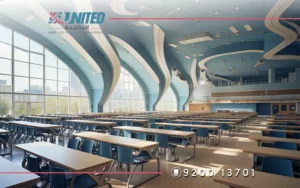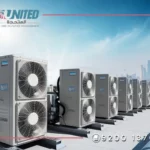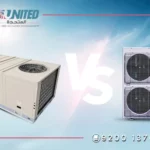The cooling capacity of the air conditioning of schools and universities is calculated with the full capacity of students (the beginning of the academic year, exam times) to overcome the large thermal load also taking into account the percentage of fresh air specified for each individual and all those criteria are indicated by the tables in the code (ASHRAE)
To address the redundant cooling capacity throughout the week, consideration is given to dividing the school or university into separate areas with air conditioning, such as feeding the reception area, corridors, classrooms, laboratories ... etc., so that this distribution allows the use of a partial operating system or phased operation, which reduces the operational cost of the place and also saves electricity and reduces maintenance operations
When distributing air outlets, students ' seating places should be taken into account so that cold air is not directed directly at them
When distributing air outlets, students ' seating places should be taken into account so that cold air is not directed directly at them
Some schools or universities have sports arenas (football fields, training arenas) and their adaptation is divided into two cases in terms of their architectural conditions, namely
First :the closed state
And it is treated as any closed space in which convection is calculated according to the standards shown by the code (ASHRAE), taking into account the calculation of a ventilation system (push and suction fans for air change )
Second: the open state
Here, when conditioning any open space for outdoor air, it is not possible to use a hidden air conditioning system or central air conditioning (closed circuit system), as this system is designed to feed cold air at a low temperature, then draw air from the place at an average temperature, and then feed it back at a low temperature, where, for example, the temperature of the return air from the space is an average, for example, 28° C, but in this case the return air is the outside air, whose temperature can reach 48 degrees C, so an air conditioning system designed for such conditions, for example, fresh air handling units (FAHU) or single-stage desert air feed units or multi-stage
When locating the thermostats that control the air conditioners, it is preferable to place them in a high place or a closed box can be installed on them, so as not to leave them to be tampered with by the students present, so that they are calibrated at an average temperature that suits everyone, and in some cases they are assembled in one place (control room) or a centralized control system is
It is preferable to install air curtains at entrances and exits to reduce the ingress of hot air inside the campus, which can negatively affect the cooling efficiency
Some air fresheners can be installed in air conditioning units and an operating system is made at a time to ensure that a good smell of the place is maintained regularly and automatically
Periodic Maintenance of air conditioners and cleaning of their filters to reduce bacteria and unpleasant odors accumulated on them and to maintain cooling efficiency
Second: ventilation
As stated in the universal code (ASHRAE) on ventilation standards for universities and schools with a high number of people or students
The air renewal process comes at the head of these standards, as the air must be changed up to 10:6 times per hour (ACH Air change rate) in bathrooms
This is done in the framework of protecting personnel from infection and reducing bacteria, also to maintain a good smell of the place.
This is done in several ways, including natural methods (ventilation holes in walls, windows ...etc.) or mechanical methods (push and suction fans, moisture extraction devices ...etc.)











